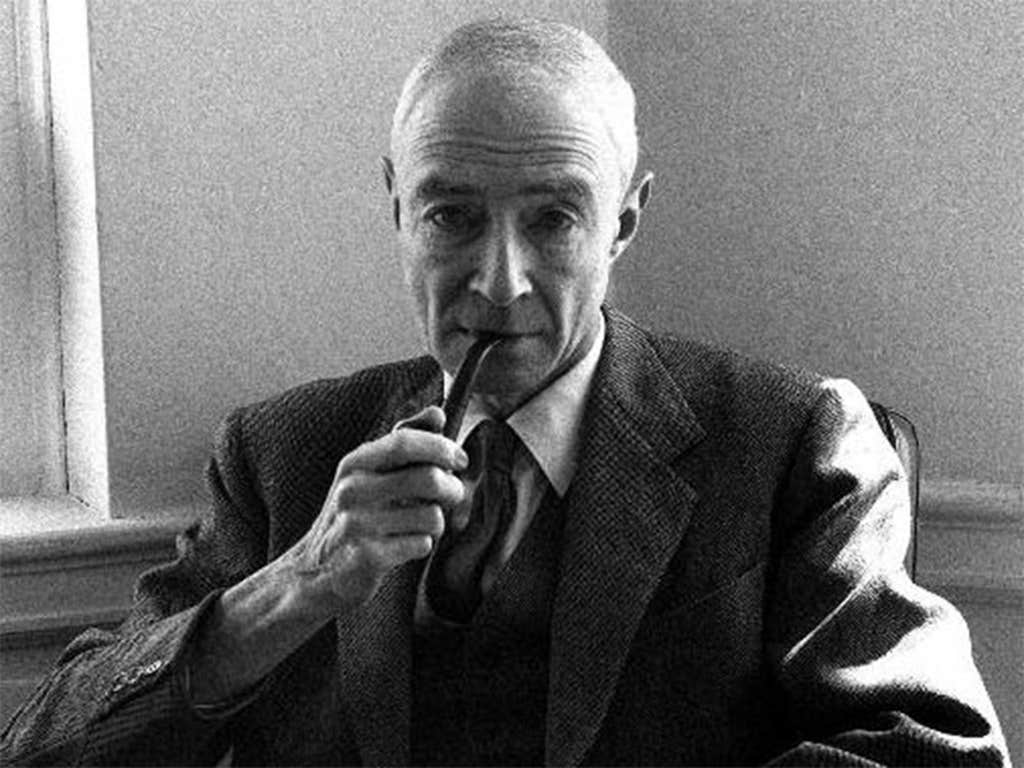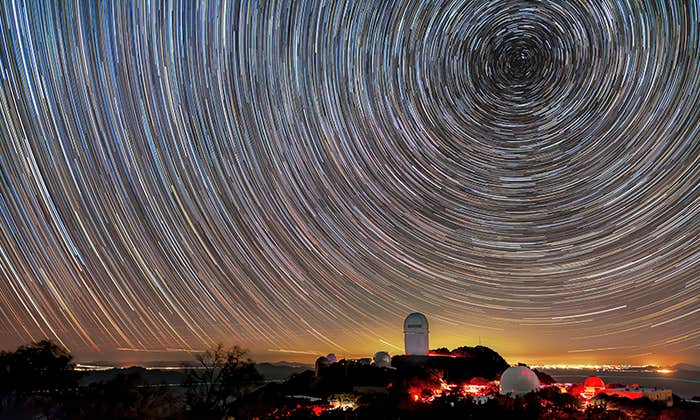In July 1943, Robert Oppenheimer called Arthur Compton to say he was coming to Michigan, where Compton was on a brief vacation with his wife and son in a lakeside house. He had to talk about a matter so important that it was worth taking the train all the way from Los Alamos, New Mexico.
Compton, a Nobel laureate in physics for his research on the interactions of light and matter, was one of the key scientific architects of the Manhattan Project, the secret operation at Los Alamos during World War II to construct an atomic bomb before the Nazis did. The project was led by Oppenheimer, an enigmatic, chain-smoking American theoretical physicist who had contributed important work in fields ranging from quantum mechanics to nuclear and molecular physics, astronomy to general relativity.
That kind of life-or-death gamble makes for a dramatic movie scene.
When Oppenheimer arrived, Compton drove him to the lake where they could talk in secrecy. In Compton’s later account, Oppenheimer explained that the Los Alamos scientists had discovered that, as well as liberating atomic energy by nuclear fission, very light atoms like hydrogen could release energy by fusing together into heavier nuclei. Such a process would only be initiated at tremendous temperatures—but that is precisely what the fission bombs would produce. If the Manhattan Project succeeded, might the bomb ignite an uncontrollable fusion chain reaction in the hydrogen of the ocean water or in the nitrogen atoms of the atmosphere? Might the bomb transform the planet’s air itself into an ever-expanding fireball?
Faced with the possibility of “ultimate catastrophe,” Compton later told writer and Nobel laureate for literature, Pearl Buck, it would be “better to accept the slavery of the Nazis than to run the chance of drawing the final curtain on mankind!”
Given the worry that German scientists working for Hitler would be pursuing their own atomic bomb, Compton and Oppenheimer decided they had no option but to press ahead with their efforts to build theirs first. At the same time, they would try to quantify the risk of igniting the air and sea.

According to Buck’s article, “The bomb—the end of the world?” which appeared in The American Weekly in 1959, Compton decided the project should only proceed if calculations gave a less-than three-in-1-million chance that an atomic bomb would vaporize the world. The scientists’ estimate allegedly satisfied that threshold—but there was no way of knowing for sure if the figures were right until the first bomb was detonated at the Trinity Site in the New Mexico desert in July 1945. That kind of life-or-death gamble makes for a dramatic magazine article—and movie scene.
The reality was more mundane. Oppenheimer seems to have been rather quickly disabused of the apocalyptic fear. In the end, his concern about nuclear fusion was not that it would be sparked accidentally by the fission bombs his team at Los Alamos had begun developing—and which would three years later obliterate at least 150,000 lives in Hiroshima and Nagasaki—but that it too would be used to create weapons of even more terrible destructive power.
The Second World War merely accelerated the inevitability of the nuclear bomb. It had been known since the end of the 19th century that certain heavy elements, especially uranium, emit energy in the form of radioactivity. In his 1914 book, The World Set Free, H. G. Wells speculated about this enormous reservoir of energy locked inside the atomic nucleus being harnessed for city-leveling weapons he called “atomic bombs.” But only shortly before the outbreak of the war did it become clear how this might be done. In 1938, the German scientists Otto Hahn and Fritz Strassmann, working in Berlin, discovered that the uranium nucleus can undergo fission, splitting into two smaller fragments with a tremendous release of energy. Hahn and Strassmann were initially perplexed by their findings; it was their former colleague Lise Meitner, recently exiled from Nazi Germany to Sweden as a person with Jewish heritage, who interpreted them as a fission process.
It was apparent almost at once to scientists studying the physics of the atomic nucleus that this process might give rise to a self-sustaining, runaway chain reaction that liberated all the energy in an instant, if it unfolded in a large enough (“critical”) mass of the fissile isotope uranium-235. With that in prospect, President Franklin D. Roosevelt was persuaded in 1941 to initiate the Manhattan Project at Los Alamos, with Oppenheimer at the helm.
Compton’s telling of the anguished lakeside meeting with Oppenheimer is a little odd because he initially suggests that it was prompted by the discovery by the Los Alamos team of nuclear fusion itself. What he seems to mean is the realization that fusion could be used for a bomb, for the possibility that light atomic nuclei could fuse to release energy was appreciated decades earlier.
“I didn’t believe it from the first minute,” physicist Hans Bethe said.
During the 1920s, the British astrophysicist Arthur Eddington had advocated hydrogen fusion as the likely source of the energy of stars like the sun. And nuclear fusion was demonstrated in a particle accelerator in 1932 by Mark Oliphant, working under the New Zealander Ernest Rutherford in Cambridge. In 1939, physicist Hans Bethe—a Nobel laureate and the leader of the theory team at Los Alamos—elucidated the main fusion reactions in the sun, and the Russian-American physicist George Gamow developed the idea with the Hungarian emigré Edward Teller, popularizing it in his 1940 book, The Birth and Death of the Sun.
It was Teller, another member of the Los Alamos team, who first raised the possibility of a “super-bomb” powered by thermonuclear fusion of hydrogen (more specifically, of the heavy-hydrogen isotope deuterium). The enormous temperatures needed to ignite fusion in the deuterium fuel would be created by a fission bomb—which then conjured up the specter of such a uranium bomb igniting the atmosphere. Teller proposed that it was possible for two nuclei of the isotope nitrogen-14 (nitrogen being the principal component of air) to fuse into various other elements, with a massive energy release.
But how likely was it really? “I didn’t believe it from the first minute,” Bethe said in a 1982 interview. If it had been him in Oppenheimer’s place, he attested, he would not have bothered to go to Michigan to discuss it with Compton. Bethe said that he found some unjustified assumptions in Teller’s calculations that made a runaway fusion process extremely unlikely.
Teller, along with physicists Emil Konopinski and Cloyd Marvin, went on to further calculate the chances, concluding that there was, after all, no danger, even with very generous estimates of the highest temperatures a fission bomb would generate. They circulated their report, designated “LA-602,” at Los Alamos, although it remained classified until 1973.
The scientists’ fears about the bomb triggering a global conflagration were little known before Buck’s 1959 article. (The American Weekly, a Sunday newspaper supplement, was founded by William Randolph Hearst, the titan of ill-researched journalism who provided the inspiration for Orson Welles’ Citizen Kane.) Bethe felt that Buck, who had no scientific background, had completely misunderstood Compton. When her story was recounted in an alarmist article by the radiation physicist H. C. Dudley in the Bulletin of the Atomic Scientists in 1975, Bethe wrote in to say that “this claim is nonsense.” In truth, you have to wonder how much of Buck’s interview really took place, given that many of her quotes repeat essentially verbatim what Compton wrote in his 1956 autobiographical account of the Manhattan Project, Atomic Quest.
Despite what Buck claimed about Compton’s three-in-1-million danger threshold for igniting the air, there was never even that, Bethe said. “Ignition is not a matter of probabilities; it is simply impossible.” As a 1947 technical history by philosopher of science and the Manhattan Project’s official historian David Hawkins attested, the calculations showed that “no matter how high the temperature, energy loss would exceed energy production [by fusion] by a reasonable factor.” The process would very quickly run out of steam, so that “the impossibility of igniting the atmosphere was thus assured by science and common sense.” What was true for the air, Bethe added, was even more true for hydrogen fusion in the oceans.
This was his fear: weapons of even more destructive power.
The possibility of global atmospheric fusion seemed potentially more of an issue—although again it was found to be not at all likely—for Teller’s much more explosive super-bomb. Teller pushed the hydrogen-bomb concept energetically even while to Bethe it seemed “a terrible thing.” Yet because Bethe assumed the German scientists would have come to the same conclusion, he decided to work on it nonetheless, in parallel with the fission bomb. That effort proceeded in earnest only after the war had ended—and the Cold War had begun. In 1952, the first hydrogen bomb, codenamed “Mike,” blasted apart the island of Elugelab in the Pacific atoll of Enewetak, creating a fireball three miles across.
The fear of an atom bomb causing a runaway conflagration was also raised—with barely the slightest understanding of the scientific issues—in discussions between Albert Speer, the German minister for armaments and war production, and Adolf Hitler, after the German physicists led by Werner Heisenberg had presented the possibility of a uranium bomb to the German High Command in 1942. Speer had asked Heisenberg if he was sure that a fission chain reaction would not continue indefinitely and had not received a clear answer. “Hitler was plainly not delighted with the possibility that the earth under his rule might be transformed into a glowing star,” Speer wrote in his 1970 book, Inside the Third Reich. “Occasionally, however, he joked that the scientists in their unworldly urge to lay bare all the secrets under heaven might some day set the globe on fire.” It was not for this reason that the German bomb project was never pursued with any real conviction, however, but because the German scientists doubted their ability to deliver a bomb in time to affect the outcome of the war. Instead the energy and funding went into the V-2 rocket project.
To anyone who has read Kurt Vonnegut’s 1963 novel, Cat’s Cradle, the tale of physicists inadvertently destroying the world has a familiar ring to it. The novel’s narrator is compiling a book called The Day the World Ended from first-hand accounts of “what important Americans had done on the day when the first atomic bomb was dropped on Hiroshima.” He goes to meet one of the Manhattan Project scientists, the fictional Felix Hoenikker, who is now researching how to make a new form of ice called ice-nine that remains frozen at room temperature. The book ends with a shard of ice-nine falling into the sea and triggering the conversion of all the oceans to this solid form. The world ends not in fire, but in ice.
Hoenikker was modeled on the American chemist and Nobel laureate Irving Langmuir, who suggested the idea of a form of ice stable at room temperature to H. G. Wells during a visit to Langmuir’s lab at the General Electric research company in the 1930s. Langmuir, said Vonnegut (whose brother worked at General Electric), “was absolutely indifferent to the uses that might be made of the truths he dug out of the rock and handed out to whoever was around, but any truth he found was beautiful in its own right, and he didn’t give a damn who got it next.”
This apocalypse is triggered not so much by amorality as by sheer carelessness. In that much, at least, it seems the Manhattan Project scientists were more careful to check out the dangers. If their bombs ended up destroying us all, it would not be because they burned up the atmosphere by mistake, but because we brought it deliberately upon ourselves.
This was Oppenheimer’s real fear. While initially he supported the H-bomb project (the “Super”), by 1949 he had turned against the idea. He considered that, if the United States pressed on with that project, it would only precipitate an arms race with the Russians. That reluctance was cited against him in the 1954 hearing by the U.S. Atomic Energy Commission, which revoked Oppenheimer’s security clearance because of his alleged left-wing sympathies. When Oppenheimer was asked when he developed moral convictions against the H-bomb, he responded, “When it became clear to me that we would use any weapon we had.” ![]()
Philip Ball is a freelance writer. His latest book is The Book of Minds.
Lead image: The Official CTBTO Photostream / Wikimedia Commons
































